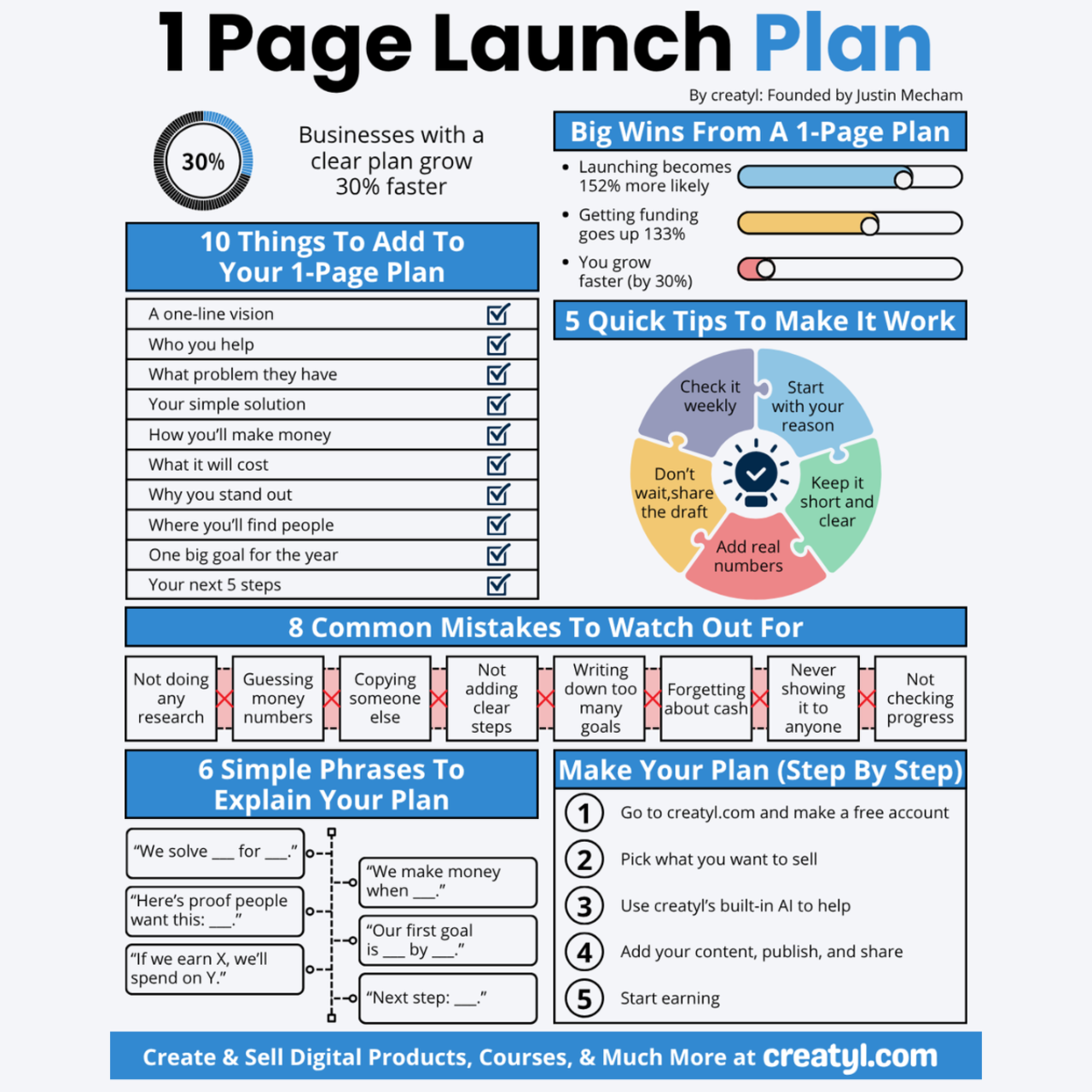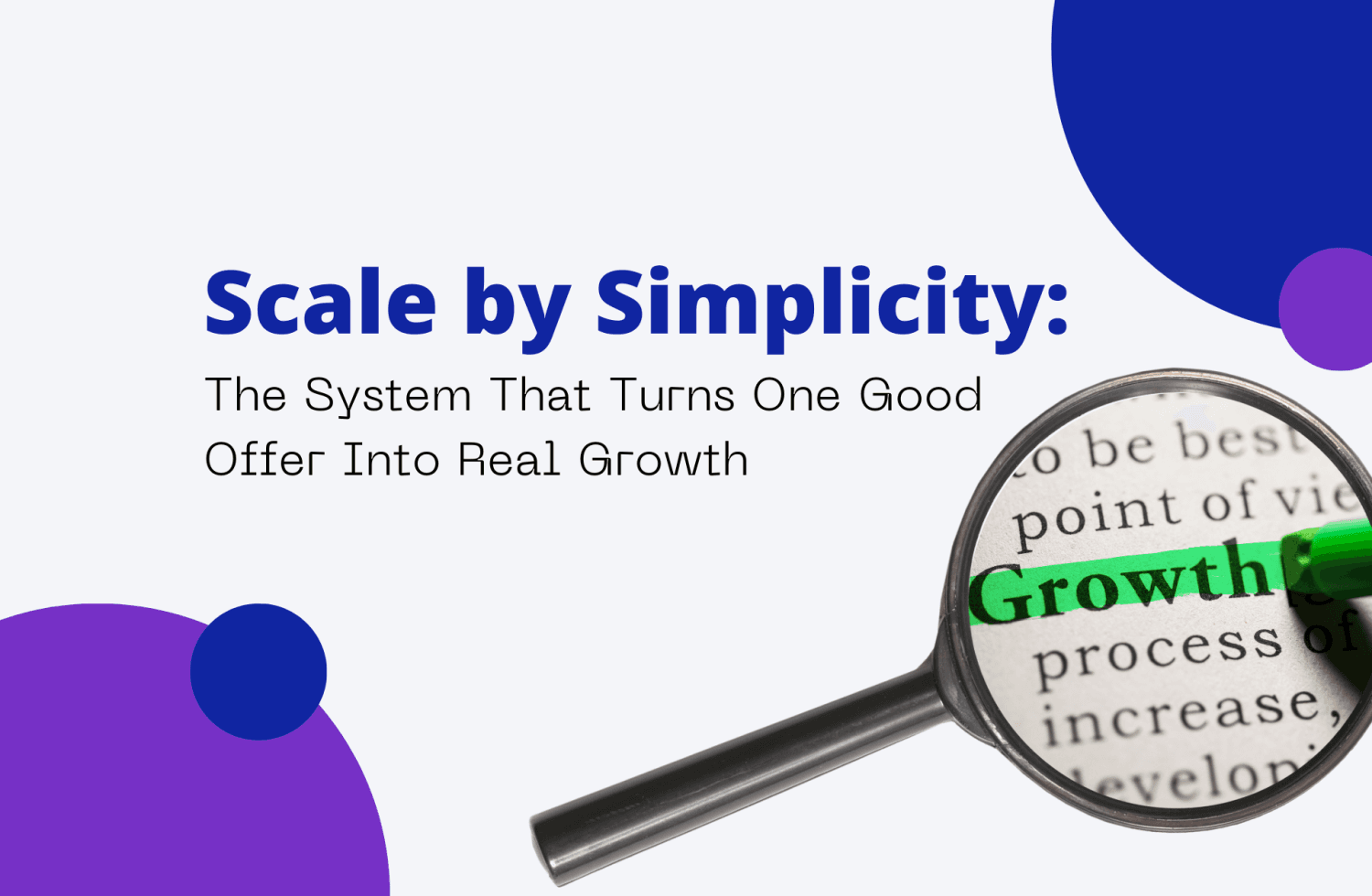If You Want Today's Infographic, Click Here.
The Real Reason Ideas Fail
Let’s get this straight: most ideas don’t fail because they’re bad.
They fail because the plan behind them is fuzzy.
You’ve seen it happen. Someone comes up with a concept that feels exciting. The kind that gets a room nodding along.
But when you dig into the details—how it works, who it’s for, what it costs—the answers get vague.
Numbers are guesses. Steps are “to be figured out.” The launch date is “sometime soon.”
Without a clear plan, momentum dies. Energy drains away.
And the idea that had everyone fired up becomes another “almost” project.
The truth is, a clear, one‑page plan can make the difference between something that fades away and something that turns into actual results.
The Data Doesn’t Lie: Planning Changes Outcomes
Research keeps saying the same thing:
- Businesses with a clear plan grow 30% faster
- They’re 133% more likely to secure funding
- They’re 152% more likely to launch successfully
And here’s the kicker—it doesn’t have to be complicated.
A one‑page plan is often more effective than a bloated 40‑page document.
When done right, it tells you exactly who you help, what problem you solve, how you make money, and the specific next moves to make it happen.
But most people still fall into the same traps:
- Copying someone else’s pitch instead of finding their own voice
- Guessing their numbers instead of getting real data
- Overloading themselves with too many goals
- Forgetting to plan for cash flow
These mistakes kill great ideas before they even get tested.
Real Stories of Fuzzy Plans and How They Got Fixed
1. The Content Team That Couldn’t Launch
A marketing team had a killer idea: a premium online course for small business owners on mastering social media.
The concept was solid. The audience was out there.
But no one could agree on the details.
Who exactly was it for? How much would it cost to make? What would they charge?
They spent six weeks “working” without getting a single paying customer or running a single test.
Deadlines slid. Conversations became circular. Leadership wanted answers the team didn’t have.
They scrapped the vague conversations and created a one‑page plan:
- One‑liner: “We help solo business owners turn social media into a 24/7 sales channel without spending more than an hour a day.”
- Actual costs: filming, editing, hosting.
- Pricing model: pulled from competitor research and customer interviews.
- One measurable goal: “10 paying customers in 30 days.”
- Five clear moves: run 3 interviews, build a simple sales page, test a $100 ad, film the first module, open early-bird enrollment.
Within a week, they had sign‑ups from people they’d interviewed.
They adjusted pricing based on feedback and launched on time—with revenue from day one.
2. The Pitch That Fell Flat With Leadership
A small corporate team pitched a new employee learning program.
They believed in it, but their pitch was full of generic buzzwords and borrowed slides from other companies.
No numbers. No proof. No milestones.
Leadership’s first question—“Why should we fund this instead of the other proposals?”—brought silence.
The team had passion, but no hard evidence. They left without funding.
They went back and rebuilt their pitch using a one‑page framework:
- A specific “We solve ___ for ___” statement.
- A real quote from a pilot user.
- A simple cost breakdown.
- A clear goal: “Train 200 employees in the first quarter at $50 per person.”
- Five next moves: finalize content, run pilot, gather feedback, refine, scale.
When they re‑pitched with that clarity, they landed a $10K pilot budget.
The pilot’s success gave them the green light to roll it out company‑wide.
3. The Team Buried in Goals
A creative department planned to launch a digital product line.
In the first meeting, they set twelve goals. Everything from “grow followers” to “get press coverage” to “attend events.”
It looked ambitious, but it was unmanageable.
Two months in, nothing was done.
Meetings were full of updates on half‑finished tasks. Everyone felt busy, but there was no actual progress.
They cut it to one focus: “Get five paying customers for our first product in 30 days.”
Their one‑page plan looked like this:
- One‑liner: “We help small event planners sell more tickets with ready‑to‑use marketing templates.”
- Cost line: $300 for ads, two weeks of staff time.
- One proof quote from a beta user.
- Five steps: identify top 50 leads, send personal outreach, test a $50 ad, create onboarding guide, follow up after purchase.
Within two weeks, they had their five paying customers and the momentum to launch the next product with confidence.
Why the One‑Page Plan Works
When you can explain your idea in one page, you’ve stripped away the clutter.
You can see exactly:
- Who you help
- What problem you solve
- How you’ll make money
- What it will cost
- The single goal you’re aiming for
- The five steps that get you there
This kind of clarity makes decision‑making faster.
It builds confidence in your team.
And it gives anyone backing you—whether it’s a boss, an investor, or a partner—the proof they need to believe it will work.
Recommended Resources for Clearer Planning
If you want to sharpen your planning skills even further, here’s an audio resource you haven’t seen recommended yet—plus the rest of the top-rated tools that complement the ideas in this article:
Podcast – Masters of Scale hosted by Reid Hoffman
Episodes dive into the real stories behind how companies scaled from idea to impact. Each episode centers on one founder’s journey, then layers on clear insights about timing, testing, costs, and decision-making—perfect for seeing how clarity beats chaos.
Book – The Lean Startup by Eric Ries
The modern go-to for understanding MVP testing, validated learning, and why you must design feedback loops into your early work.
TED Talk – The Single Biggest Reason Why Start‑ups Succeed by Bill Gross
Gross researched hundreds of startups and found timing, clarity, and execution matter more than money or team. His talk underlines why a sharp plan wins.
AI/Tool – LivePlan
A business planning platform that guides you through clear financial modeling, simple templates, and presentation-ready planning—ideal for creating a one‑page plan an investor or team can follow quickly.
Each of these brings a different angle: inspiring founders’ stories, startup-tested frameworks, or step-by-step tools to actually build your plan.
The Power of Clarity Over Everything
The strongest ideas don’t win just because they’re brilliant. They win because they’re clear.
Clarity forces you to be specific about who you serve, how you’ll serve them, and what success actually looks like.
It replaces guesswork with real numbers and replaces “someday” with exact steps.
It gives you something to measure against so you can see—quickly—what’s working and what’s not.
It turns a vague “we should do this” conversation into a shared commitment everyone can follow.
Without clarity, even the best ideas stall. With it, even modest ideas can grow into something remarkable.
Because when you know exactly where you’re going and exactly how you’ll get there, every step forward feels less like a gamble—and more like the obvious next move.
Download the Infographic as a PDF
Want the full visual version of this one‑page plan so you can keep it handy?
We’ve created a clean, ready‑to‑use PDF you can download and reference anytime.




